How Sea Fog Influences Inland Visibility on the Southern China Coast
Abstract
:1. Introduction
2. Observational Sites and Data
2.1. Observational Sites and Data
2.2. Satellite Data
2.3. Other Data
3. Synoptic Backgrounds and Influence on Inland Visibility of the Two Cases
4. Advection and Boundary-Layer Characteristics
5. Differences of Meteorological Variables
6. Differences of Land–Atmosphere and Air–Sea Exchange between the Two Cases
7. Discussion and Conclusions
- (1)
- In both cases, the synoptic conditions involved warm, moist air from a warmer SST region advecting to a colder SST area at the coast, forming sea fog. But, the inland fog case had larger horizontal advection of water vapor over the land and about 80% low-cloud coverage.
- (2)
- The surrounding boundary layer was important. Both sea-fog cases had low wind speeds and a small TKE. The small TKE allowed the vapor to accumulate close to the surface and maintain the local cooling effect, eventually producing fog.
- (3)
- Both cases had radiative cooling of the ground, but the inland fog case had a downward energy flux at night, with the land surface cooling the atmosphere. The non-fog case had the opposite flux. The fog case also had lower soil temperature and higher soil humidity.
Author Contribution
Acknowledgments
Conflicts of Interest
References
- Lewis, J.M.; Koračin, D.; Redmond, K.T. Sea fog research in the United Kingdom and United States: A historical essay including outlook. Bull. Am. Meteorol. Soc. 2004, 85, 395–408. [Google Scholar] [CrossRef]
- Bergot, T. Quality assessment of the Cobel-Isba numerical forecast system of fog and low clouds. Pure Appl. Geophys. 2007, 164, 1265–1282. [Google Scholar] [CrossRef]
- Gultepe, I.; Tardif, R.; Michaelides, S.C.; Cermak, J.; Bott, A.; Bendix, J.; Müller, M.D.; Pagowski, A.; Hansen, B.; Ellrod, G.; et al. Fog research: A review of past achievements and future perspectives. Pure Appl. Geophys. 2007, 164, 1121–1159. [Google Scholar] [CrossRef]
- Koračin, D.; Dorman, C.E.; Lewis, J.M.; Hudson, J.G.; Wilcox, E.M.; Torregrosa, A. Marine fog: A review. Atmos. Res. 2014, 143, 142–175. [Google Scholar] [CrossRef]
- Lamb, H. Haars or North Sea Fogs on the Coasts of Great Britain; Meteorology Office Publication: Devon, UK, 1943. [Google Scholar]
- Leipper, D.F. Fog on the United States west coast: A review. Bull. Am. Meteorol. Soc. 1994, 75, 229–240. [Google Scholar] [CrossRef]
- Koračin, D.; Businger, J.A.; Dorman, C.E.; Lewis, J.M. Formation, evolution, and dissipation of coastal sea fog. Bound. Layer Meteorol. 2005, 117, 447–478. [Google Scholar] [CrossRef]
- Petterssen, S. Some Aspects of Formation and Dissipation of Fog; Geofysiske Publikasjoner: Olso, Norway, 1939. [Google Scholar]
- Jiusto, J.E. Fog Structure. In Clouds, Their Formation, Optical Properties, and Effects; Hobbs, P.V., Deepak, A., Eds.; Academic Press: New York, NY, USA, 1981; pp. 187–239. [Google Scholar]
- Duynkerke, P.G. Radiation fog: A comparison of model simulations with detailed observations. Mon. Weather Rev. 1991, 119, 324–341. [Google Scholar] [CrossRef]
- Bergot, T.; Guedalia, D. Numerical forecasting of radiation fog. Part I: Numerical model and sensitivity tests. Mon. Weather Rev. 1994, 122, 1218–1230. [Google Scholar] [CrossRef]
- Duynkerke, P.G. Turbulence, radiation and fog in Dutch stable boundary layers. Bound. Layer Meteorol. 1999, 90, 447–477. [Google Scholar] [CrossRef]
- Zhou, B.; Ferrier, B.S. Asymptotic analysis of equilibrium in radiation fog. J. Appl. Meteorol. Climatol. 2008, 47, 1704–1722. [Google Scholar] [CrossRef]
- Steeneveld, G.J.; Wokke, M.J.J.; Groot Zwaaftink, C.D.; Pijlman, S.; Heusinkveld, B.G.; Jacobs, A.F.G.; Holtslag, A.A.M. Observations of the radiation divergence in the surface layer and its implication for its parameterization in numerical weather prediction models. J. Geophys. Res. 2010, 115, D06107. [Google Scholar] [CrossRef]
- Sun, J.X.; Huang, H.J.; Zhang, S.P.; Liu, J.W.; Wang, Q. Impact of sea fog on coastal area: Analysis of two cases over the Yellow Sea in spring 2008. Oceanol. Limnol Sin. 2017, 48, 483–497. (In Chinese) [Google Scholar]
- Wang, B.H. Sea Fog; China Ocean Press: Beijing, China, 1985; p. 330. [Google Scholar]
- Writing Group of Guangdong Provincial Meteorological Bureau. Manual of Weather Forecast Technology in Guangdong Province; China Meteorological Press: Beijing, China, 2006; p. 526. [Google Scholar]
- Zhang, G.C. The progress of fog forecast operation in China. Adv. Meteorol. Sci. Technol. 2016, 6, 42–48. (In Chinese) [Google Scholar] [CrossRef]
- Huang, J.; Chan, P. Progress of marine meteorological observation experiment at Maoming of South China. J. Trop. Meteorol. 2011, 17, 418–429. [Google Scholar]
- Huang, J.; Wang, B.; Zhou, F.X.; Huang, F.; Lv, W.H.; Huang, H.M.; Huang, H.J.; Yang, Y.Q.; Mao, W.K. Turbulent heat exchange in a warm sea fog event on the coast of South China. Chin. J. Atmos. Sci. 2010, 34, 715–725. (In Chinese) [Google Scholar]
- Huang, H.J.; Liu, H.N.; Jiang, W.M.; Huang, J.; Mao, W.K. Characteristics of the boundary layer structure of sea fog on the coast of Southern China. Adv. Atmos. Sci. 2011, 28, 1377–1389. [Google Scholar] [CrossRef]
- Huang, H.J.; Liu, H.N.; Huang, J.; Mao, W.K.; Bi, X.Y. Atmospheric boundary layer structure and turbulence during sea fog on the Southern China coast. Mon. Weather Rev. 2015, 143, 1907–1923. [Google Scholar] [CrossRef]
- Huang, H.J.; Mao, W.K. The South China sea monsoon experiment—Boundary layer height (SCSMEX-BLH): Experimental design and preliminary results. Mon. Weather Rev. 2015, 143, 5035–5053. [Google Scholar] [CrossRef]
- Bolton, D. The computation of equivalent potential temperature. Mon. Weather Rev. 1980, 108, 1046–1053. [Google Scholar] [CrossRef]
- Foken, T.; Gӧckede, M.; Mauder, M.; Mahrt, L.; Amiro, B.; Munger, W. Post-field data quality control. In Handbook of Micrometeorology: A Guide for Surface Flux Measurement and Analysis; Lee, X.H., Massman, W., Law, B., Eds.; Kluwer Academic Publishers: Dordrecht, The Netherlands, 2004; pp. 181–208. [Google Scholar]
- Bessho, K.; Date, K.; Hayashi, M.; Ikeda, A.; Imai, T.; Inoue, H.; Kumagai, Y.; Miyakawa, T.; Murata, H.; Ohno, T.; et al. An introduction to Himawari-8/9—Japan’s new-generation geostationary meteorological satellites. J. Meteorol. Soc. Jpn. 2016, 94, 151–183. [Google Scholar] [CrossRef]
- Zhang, S.; Yi, L. A comprehensive dynamic threshold algorithm for daytime sea fog retrieval over the Chinese adjacent seas. Pure Appl. Geophys. 2013, 170, 1931–1944. [Google Scholar] [CrossRef]
- Wu, X.; Li, S. Automatic sea fog detection over Chinese adjacent oceans using Terra/MODIS data. Int. J. Remote Sens. 2014, 35, 7430–7457. [Google Scholar] [CrossRef]
- Gao, S.H.; Wu, W.; Zhu, L.L.; Fu, G.; Huang, B. Detection of nighttime sea fog/stratus over the Huang-hai Sea using MTSAT-1R IR data. Acta Oceanol. Sin. 2009, 28, 23–35. [Google Scholar]
- Thiébaux, J.; Rogers, E.; Wang, W.Q.; Katz, B. A new high-resolution blended real-time global sea surface temperature analysis. Bull. Am. Meteorol. Soc. 2003, 84, 645–656. [Google Scholar] [CrossRef]
- Draxler, R.R.; Hess, G.D. An overview of the HYSPLIT_4 modeling system of trajectories, dispersion, and deposition. Aust. Meteorol. Mag. 1998, 47, 295–308. [Google Scholar]
- Stull, R.B. An Introduction to Boundary Layer Meteorology; Kluwer Academic Publishers: Norwell, The Netherlands, 1988; p. 666. [Google Scholar]
- Ramage, C.S. Monsoon Meteorology; Academic Press: New York, NY, USA, 1971; p. 296. [Google Scholar]
- Arya, S.P. Introduction to Micrometeorology; Academic Press: San Diego, CA, USA, 2001; p. 415. [Google Scholar]


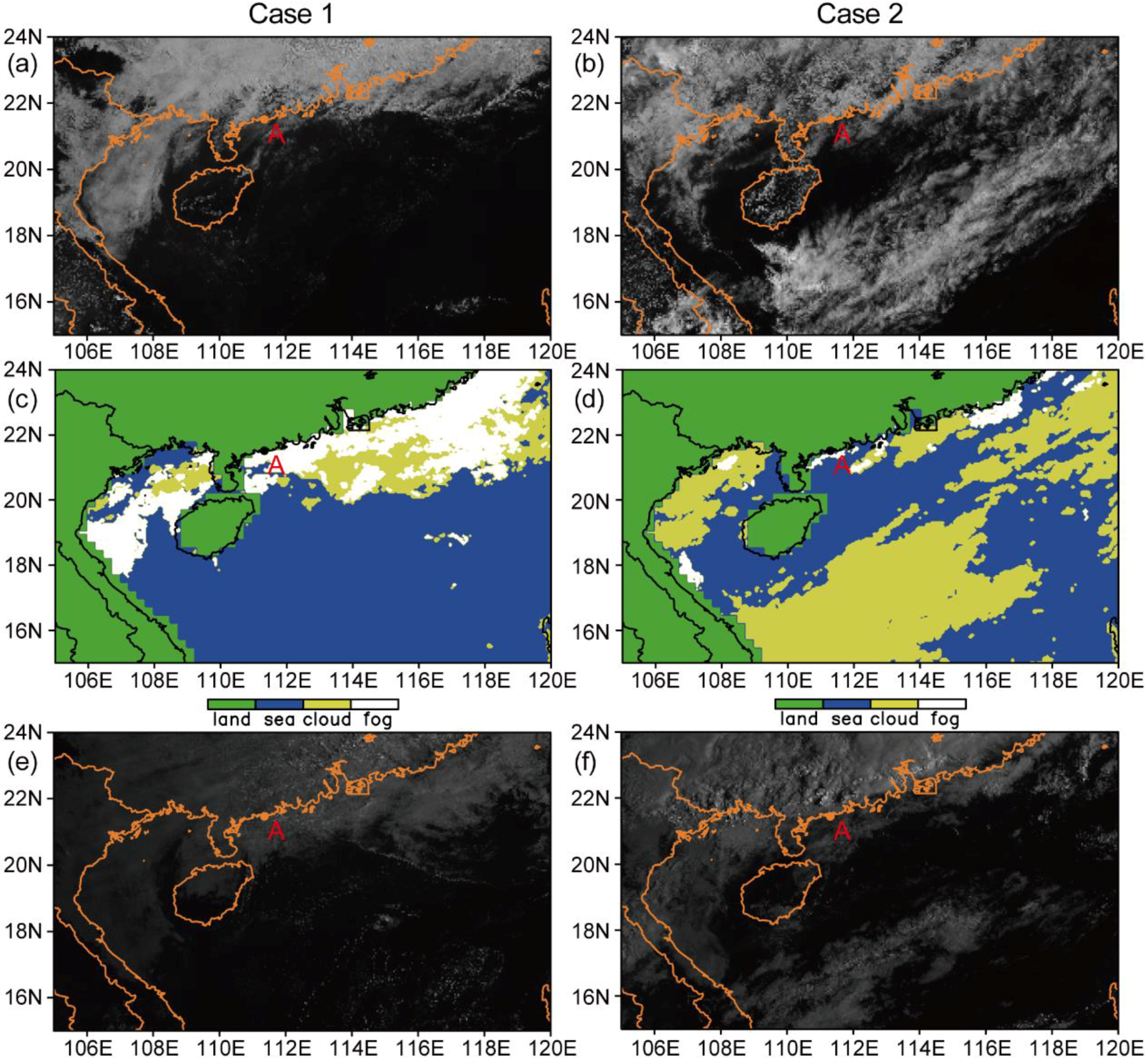


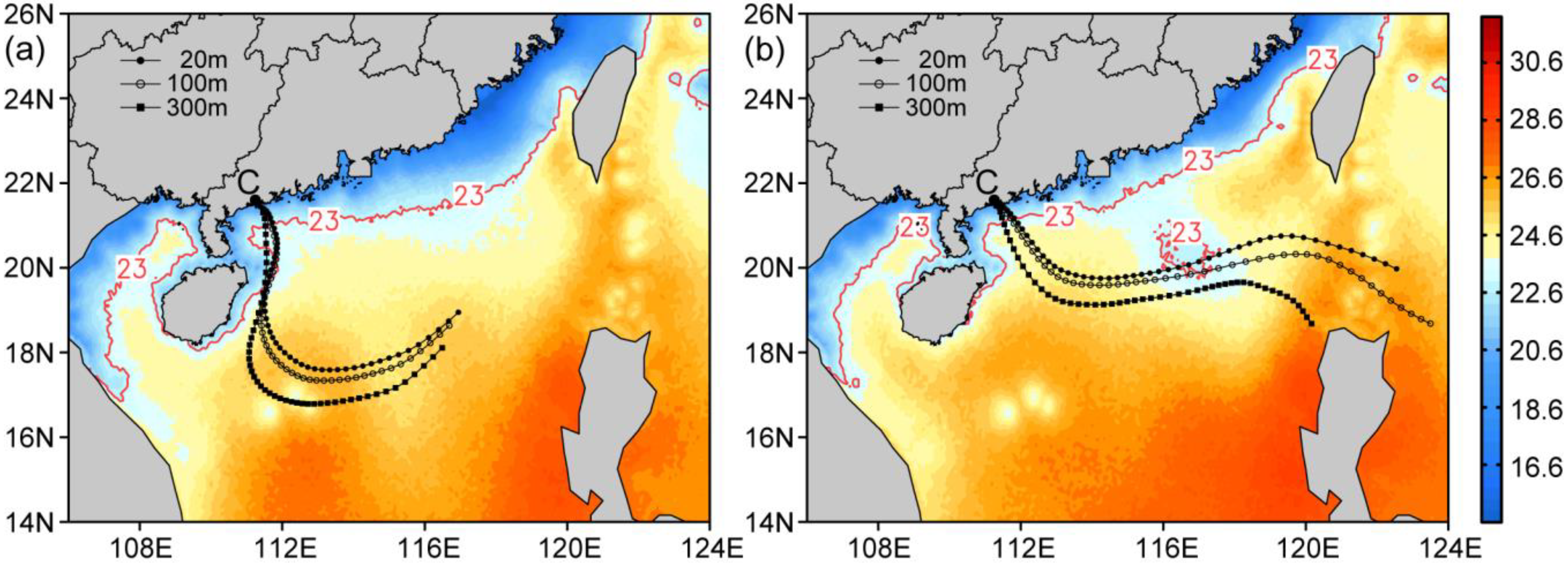

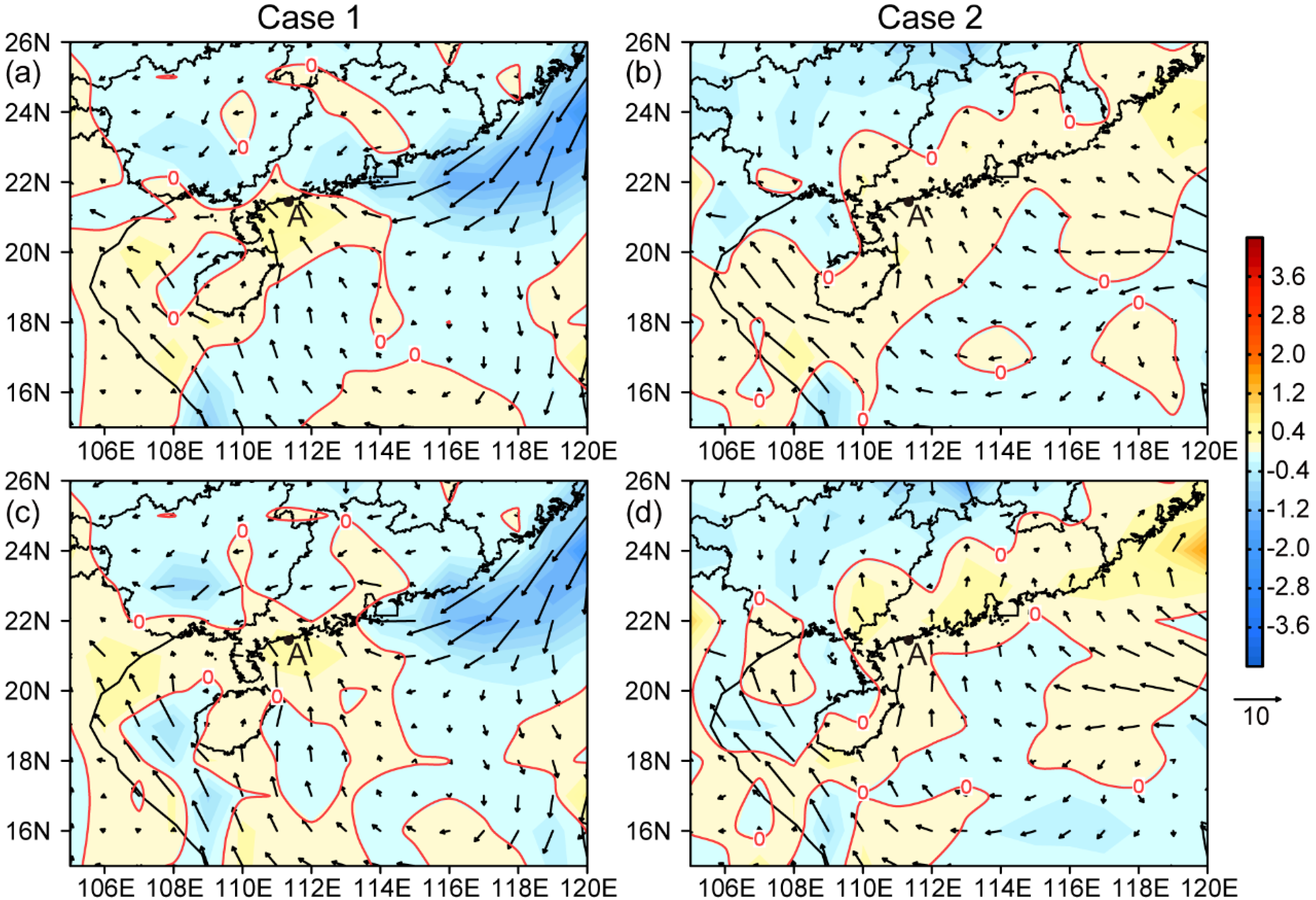
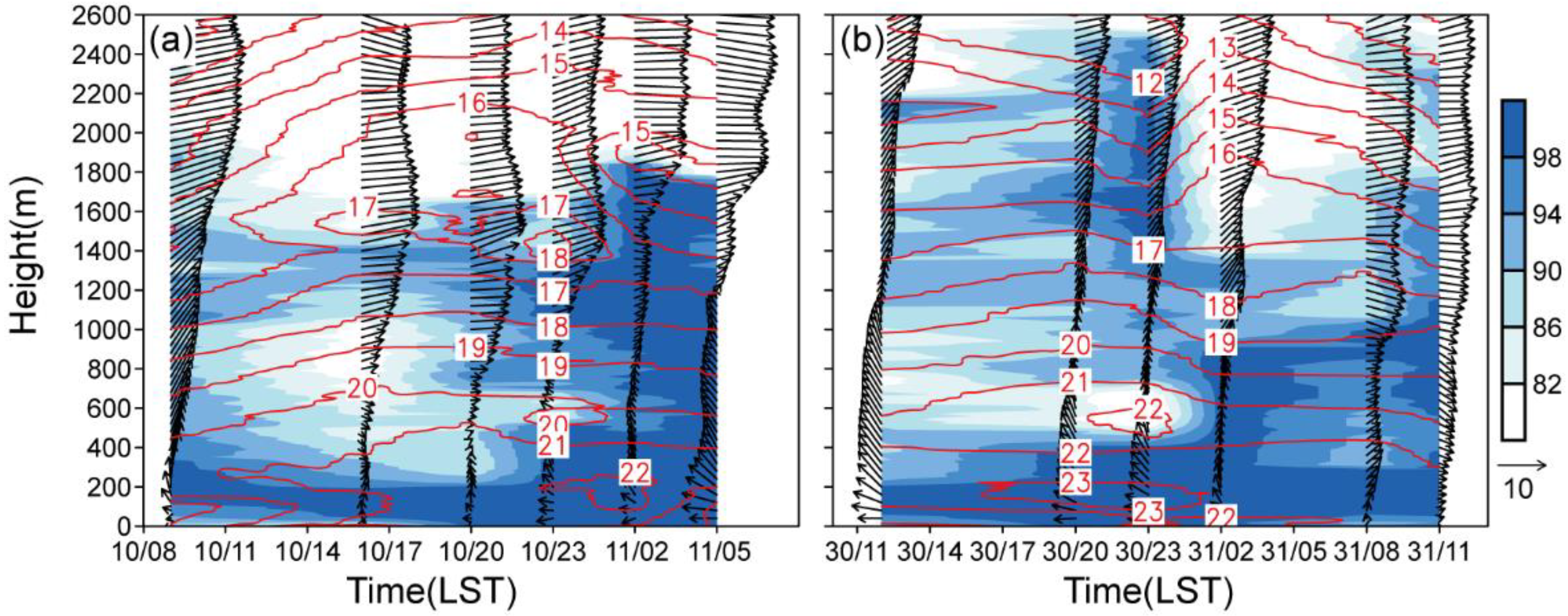
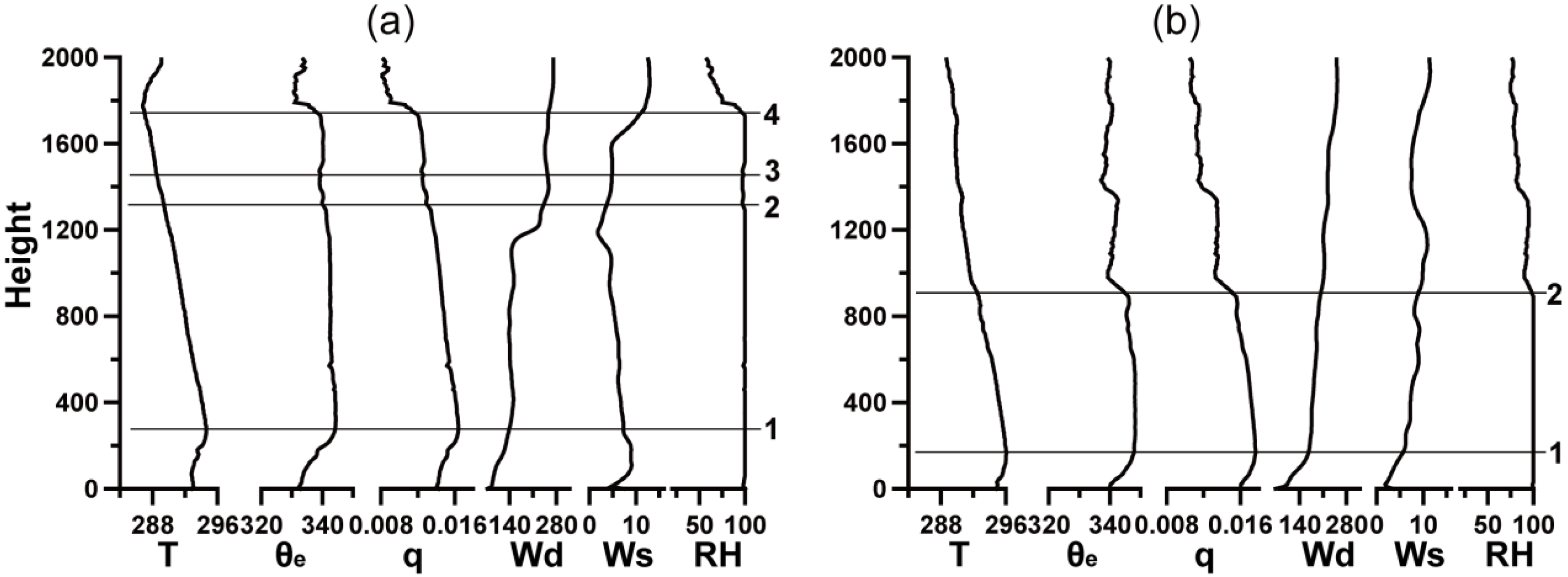

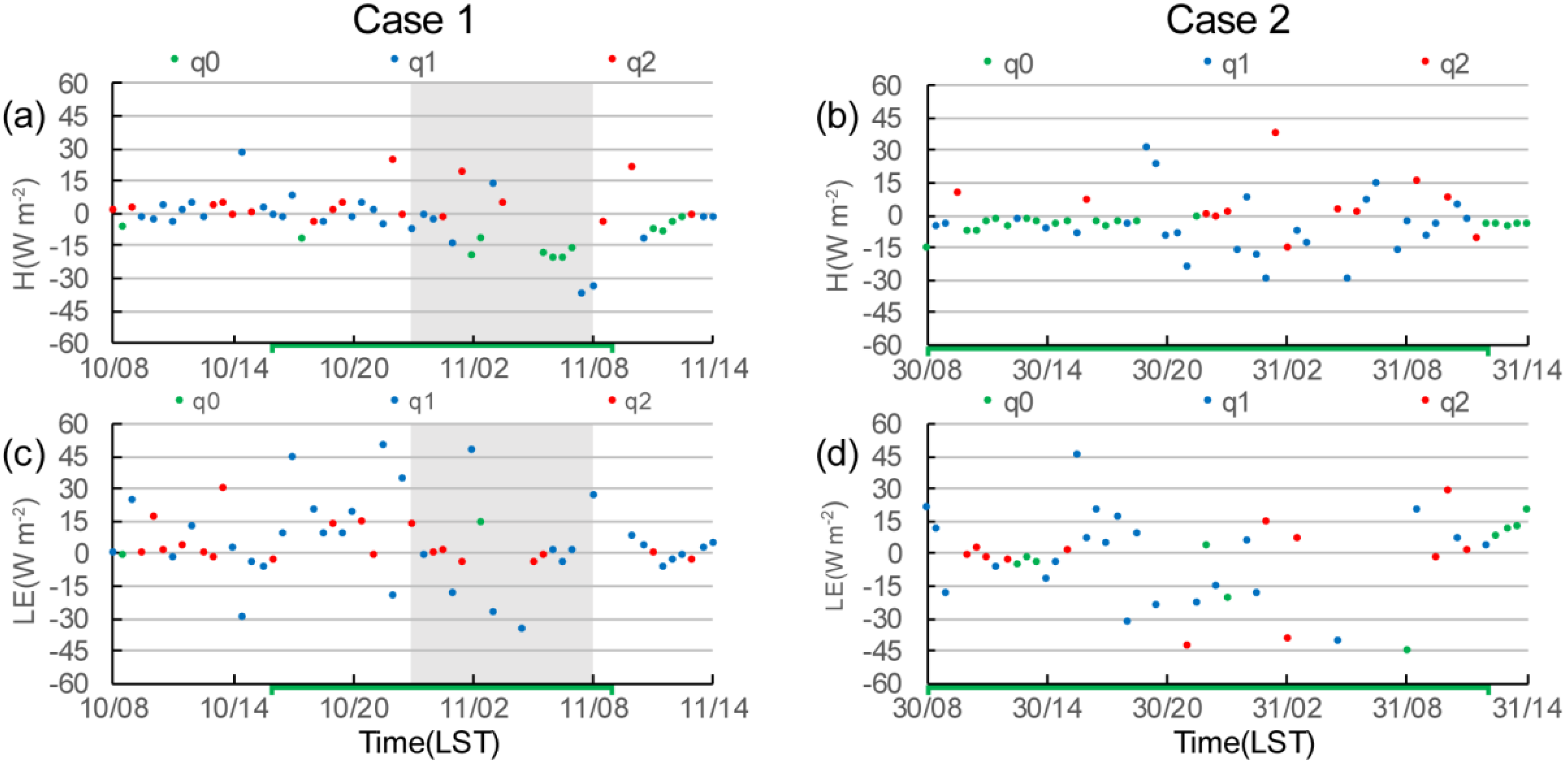

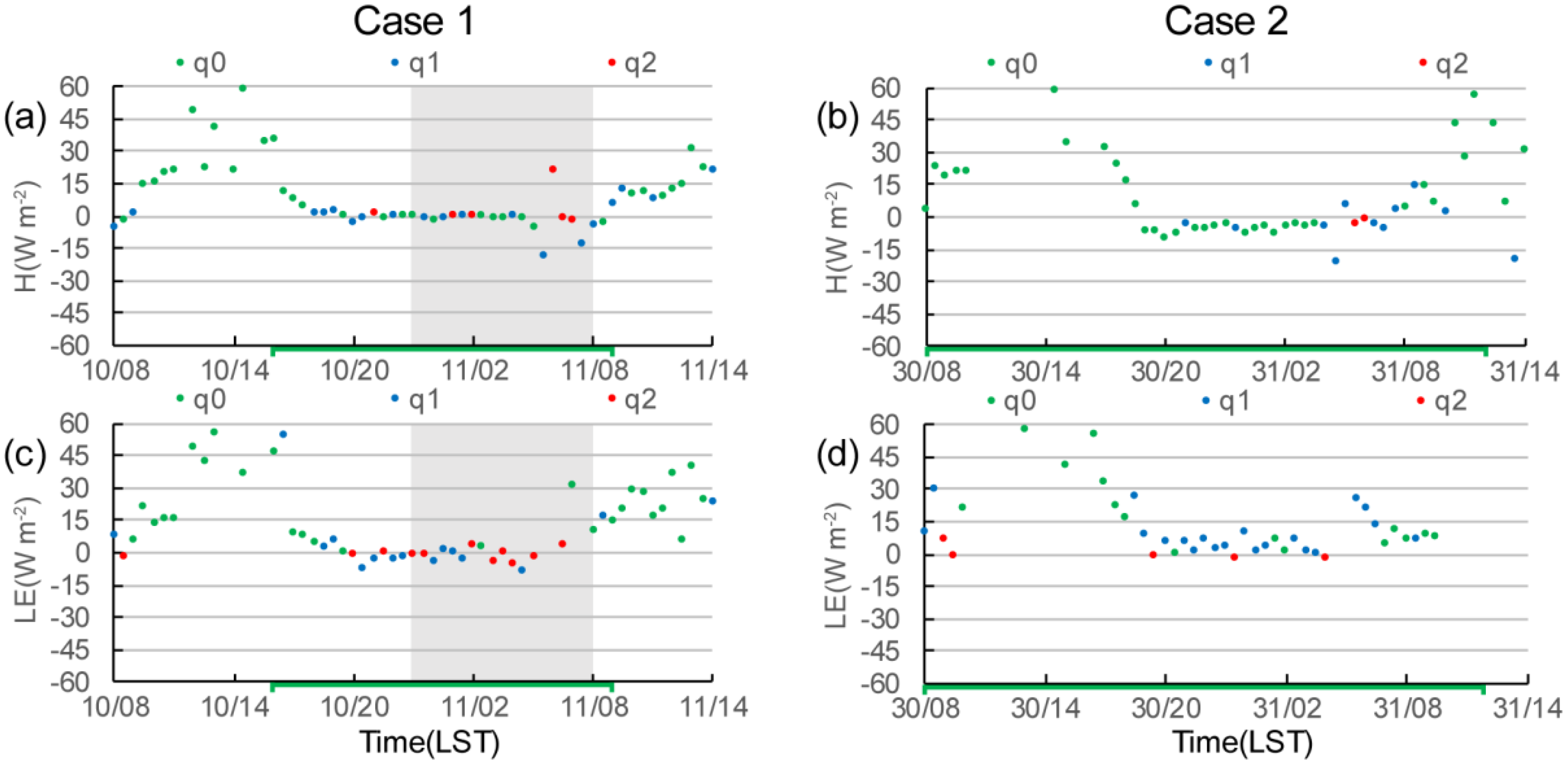
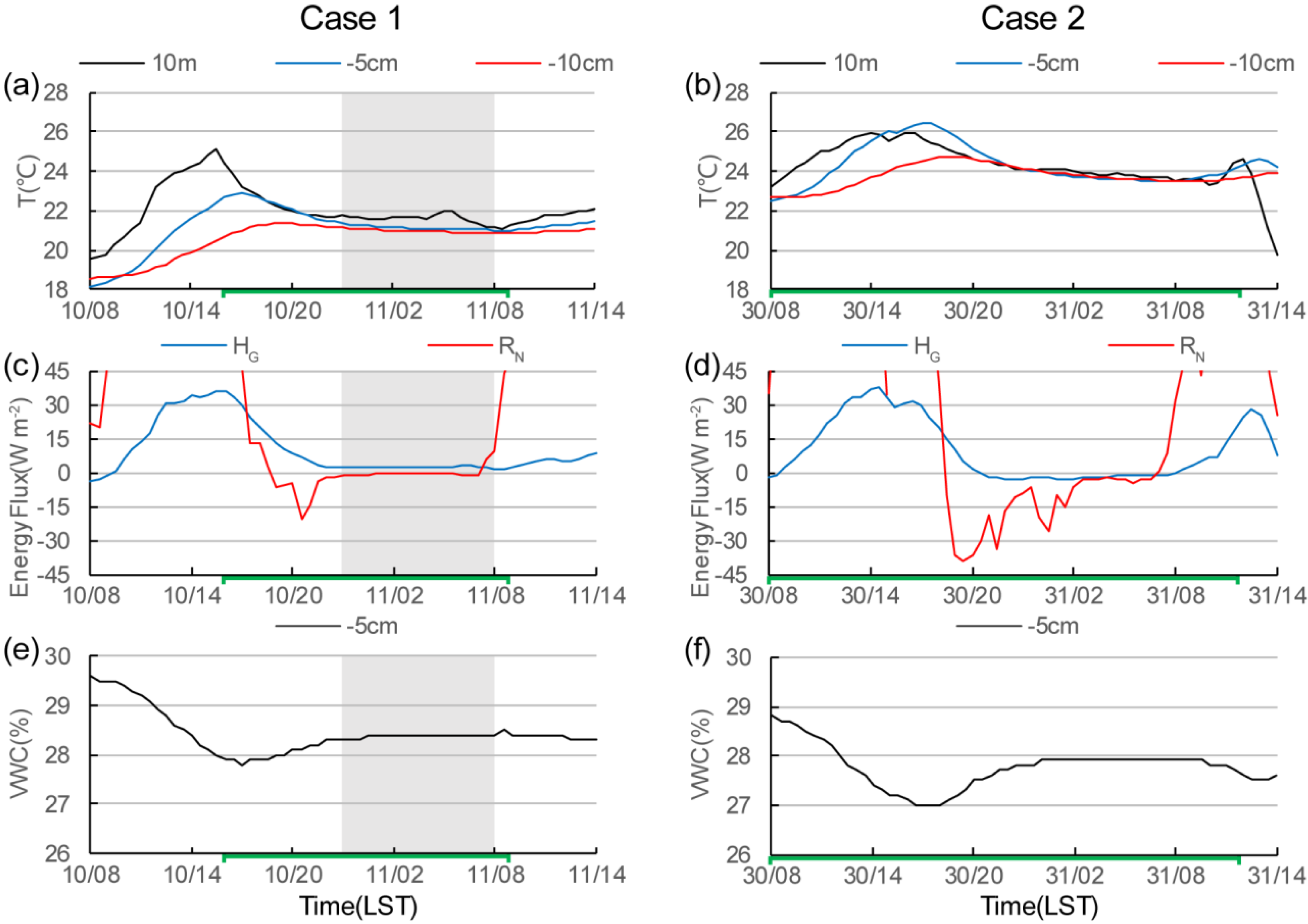
| Instrument Type or Measurement Variables | Make and Model | Observation Sites and Nominal Height(s) | ||
|---|---|---|---|---|
| MMSEB (A) | IOPMM (B) | DNCO (C) | ||
| Ultrasonic Anemometer, Infrared CO2/H2O Analyzers | U.K. Gill Windmaster Pro; USA LI-COR LI-7500A | —— | 23.4 m MSL * | 10 m AGL ** |
| GPS Sonde | Finland Vaisala RS-92 | 7 m MSL | —— | —— |
| Radiometer | Netherlands Kipp and Zonen CMP22/CGR4; CNR_4 | 1.5 m AGL | 12 m MSL | 1.5 m AGL |
| Gradients of Wind, Temperature, and Humidity | USA RM. Young 05106; Finland Vaisala HMP45d | —— | 13.4, 16.4, 20.0, 27.3 m MSL | 10 m AGL |
| Pressure | USA Setra Setraceram CS100 | —— | 13 m MSL | 1.5 m AGL |
| Rain gauge | USA Campbell TB4 | —— | 12 m MSL | 1.5 m AGL |
| Ground Temperature and Humidity | USA Campbell 109SS; Campbell CS616 | −5, −10, −20, −40 cm AGL | —— | −5, −10, −20, −40 cm AGL |
| Skin Temperature | USA Campbell IRR-P | —— | 8 m MSL | 1.5 m AGL |
| Soil Heat-Flux Plate | USA Campbell HFP01SC | —— | —— | −5 cm AGL |
| Auto Meteorological Station (six variables) | China Guangdong Observation Center, WP3103 | 1.5 m AGL | —— | 1.5 m AGL |
| Visibility | USA Belfort Model 6000 | 1.5 m AGL | —— | —— |
| Liquid-Water Content | USA DMT Model FM-120 | 1.5 m AGL | —— | —— |
| Datalogger | USA Campbell Scientific CR3000 | 7 m MSL | 13 m MSL | 1.5 m AGL |
| RNcov (%) * | ITCσ (%) ** | QA/QC Flag | Data Quality | This Study |
|---|---|---|---|---|
| ≤30 | ≤30 | 0 | High | q0 |
| ≤100 | ≤100 | 1 | Moderate | q1 |
| >100 | >100 | 2 | Low | q2 |
| Observation Site | Goal | Case 1 | Case 2 |
|---|---|---|---|
| Coast | Boundary layer structure (GPS sonde release times) | 0900, 1600, 2000, 2300 LST 10 March; 0200, 0500 LST 11 March | 1200, 2000, 2300 LST 30 March; 0200, 0800, 1100 LST 31 March |
| Oversea | Turbulence near the sea surface | 0800 LST 10 March-1400 LST 11 March | 0800 LST 30 March-1400 LST 31 March |
| Inland | Turbulence near the land surface | 0800 LST 10 March-1400 LST 11 March | 0800 LST 30 March-1400 LST 31 March |
| Before the Sea Fog | Sea-Fog Period | After Sea Fog | |||||||
|---|---|---|---|---|---|---|---|---|---|
| Case 1 | Day and time (LST) | 1400 LST March 10 | 1700 LST March 10 | 2000 LST March 10 | 2300 LST March 10 | 0200 LST March 11 | 0500 LST March 11 | 0800 LST March 11 | 1100 LST March 11 |
| Cloud * | 300, 7/7 | 1000, 10/8 | 1000, 8/8 | -, 9/- | -, 9/- | -, 9/- | 1000, 8/8 | 1000, 8/8 | |
| Visibility (km) | 9.0 | 9.0 | 6.0 | 1.1 | 0.1 | 0.1 | 1.6 | 8.0 | |
| Weather phenomena | Cloudy | Overcast | Light fog | Light fog | Fog | Fog | Light fog | Overcast | |
| Case 2 | Day and time (LST) | 1700 LST March 30 | 2000 LST March 30 | 2300 LST March 30 | 0200 LST March 31 | 0500 LST March 31 | 0800 LST March 31 | 1100 LST March 31 | 1400 LST March 31 |
| Cloud | 300, 7/7 | 300, 6/6 | -, 9/- | -, 9/- | -, 9/- | 1000, 8/8 | 300, 7/7 | 300, 7/7 | |
| Visibility (km) | 20.0 | 12.0 | 7.0 | 11.0 | 3.2 | 3.5 | 30.0 | 30.0 | |
| Weather phenomena | Cloudy | Cloudy | Light fog | Overcast | Light fog | Light fog | Cloudy | Cloudy | |
© 2018 by the authors. Licensee MDPI, Basel, Switzerland. This article is an open access article distributed under the terms and conditions of the Creative Commons Attribution (CC BY) license (http://creativecommons.org/licenses/by/4.0/).
Share and Cite
Sun, J.; Huang, H.; Zhang, S.; Mao, W. How Sea Fog Influences Inland Visibility on the Southern China Coast. Atmosphere 2018, 9, 344. https://doi.org/10.3390/atmos9090344
Sun J, Huang H, Zhang S, Mao W. How Sea Fog Influences Inland Visibility on the Southern China Coast. Atmosphere. 2018; 9(9):344. https://doi.org/10.3390/atmos9090344
Chicago/Turabian StyleSun, Jianxiang, Huijun Huang, Suping Zhang, and Weikang Mao. 2018. "How Sea Fog Influences Inland Visibility on the Southern China Coast" Atmosphere 9, no. 9: 344. https://doi.org/10.3390/atmos9090344
APA StyleSun, J., Huang, H., Zhang, S., & Mao, W. (2018). How Sea Fog Influences Inland Visibility on the Southern China Coast. Atmosphere, 9(9), 344. https://doi.org/10.3390/atmos9090344





